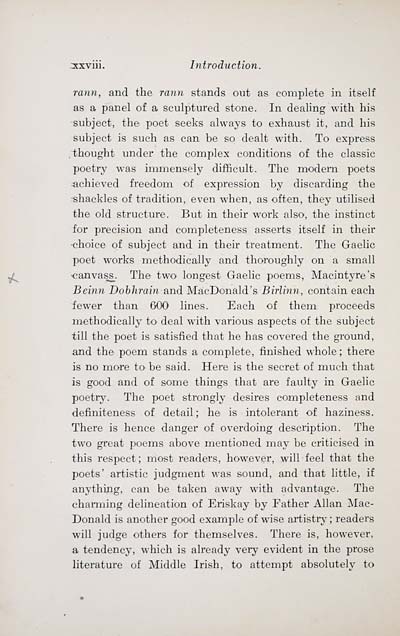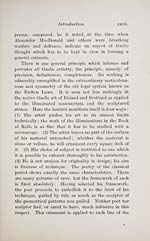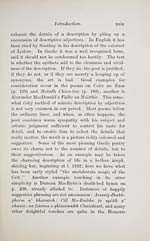Download files
Complete book:
Individual page:
Thumbnail gallery: Grid view | List view

:xxviii. Introduciion.
rann, and the rann stands out as complete in itself
as a panel of a sculptured stone. In dealing with his
subject, the poet seeks always to exhaust it, and his
subject is such as can be sq dealt with. To express
.thought under the complex conditions of the classic
poetry was immensely difficult. The modem poets
■achieved freedom of expression by discarding the
shackles of tradition, even when, as often, they utihsed
the old structure. But in their work also, the instinct
for precision and completeness asserts itself in their
choiee of subject and in their treatment. The Gaehc
poet works methodically and thoroughly on a small
■canvass_. The two longest Gaehc poems, Macintyre's
Beinn Dobhrain and MacDonald's Birlinn, contain each
fewer than 60O lines. Each of them proceeds
methodically to deal with various aspects of the subject
till the poet is satisfied that he has covered the ground,
and the poem stands a complete, finished whole; there
is no more to be said. Here is the secret of much that
is good and of some things that are faulty in GaeHc
poetry. The poet strongly desires completeness and
definiteness of detail; he is intolerant of haziness.
There is hence danger of overdoing description. The
two great poems above mentioned may be criticised in
this respect; most readers, however, will feel that the
poets' artistic judgment v/as sound, and that httle, if
anythÌBg, can be taken away wnth advantage. The
charming dehneation of Eriskay by Father Allan Mac-
Donald is another good example of wise artistry ; readers
wiU judge others for themselves. There is, however,
a tendency, which is ah-eady very evident in the prose
hterature of Middle Irish, to attempt absokitely to
rann, and the rann stands out as complete in itself
as a panel of a sculptured stone. In dealing with his
subject, the poet seeks always to exhaust it, and his
subject is such as can be sq dealt with. To express
.thought under the complex conditions of the classic
poetry was immensely difficult. The modem poets
■achieved freedom of expression by discarding the
shackles of tradition, even when, as often, they utihsed
the old structure. But in their work also, the instinct
for precision and completeness asserts itself in their
choiee of subject and in their treatment. The Gaehc
poet works methodically and thoroughly on a small
■canvass_. The two longest Gaehc poems, Macintyre's
Beinn Dobhrain and MacDonald's Birlinn, contain each
fewer than 60O lines. Each of them proceeds
methodically to deal with various aspects of the subject
till the poet is satisfied that he has covered the ground,
and the poem stands a complete, finished whole; there
is no more to be said. Here is the secret of much that
is good and of some things that are faulty in GaeHc
poetry. The poet strongly desires completeness and
definiteness of detail; he is intolerant of haziness.
There is hence danger of overdoing description. The
two great poems above mentioned may be criticised in
this respect; most readers, however, will feel that the
poets' artistic judgment v/as sound, and that httle, if
anythÌBg, can be taken away wnth advantage. The
charming dehneation of Eriskay by Father Allan Mac-
Donald is another good example of wise artistry ; readers
wiU judge others for themselves. There is, however,
a tendency, which is ah-eady very evident in the prose
hterature of Middle Irish, to attempt absokitely to
Set display mode to: Large image | Transcription
Images and transcriptions on this page, including medium image downloads, may be used under the Creative Commons Attribution 4.0 International Licence unless otherwise stated. ![]()
| Early Gaelic Book Collections > Matheson Collection > Bardachd Ghaidhlig > (32) |
|---|
| Permanent URL | https://digital.nls.uk/76422913 |
|---|
| Description | Specimens of Gaelic poetry 1550-1900. |
|---|---|
| Shelfmark | Mat.50 |
| Additional NLS resources: | |
| Attribution and copyright: |
|
| Description | Items from a collection of 170 volumes relating to Gaelic matters. Mainly philological works in the Celtic and some non-Celtic languages. Some books extensively annotated by Angus Matheson, the first Professor of Celtic at Glasgow University. |
|---|
| Description | Selected items from five 'Special and Named Printed Collections'. Includes books in Gaelic and other Celtic languages, works about the Gaels, their languages, literature, culture and history. |
|---|

